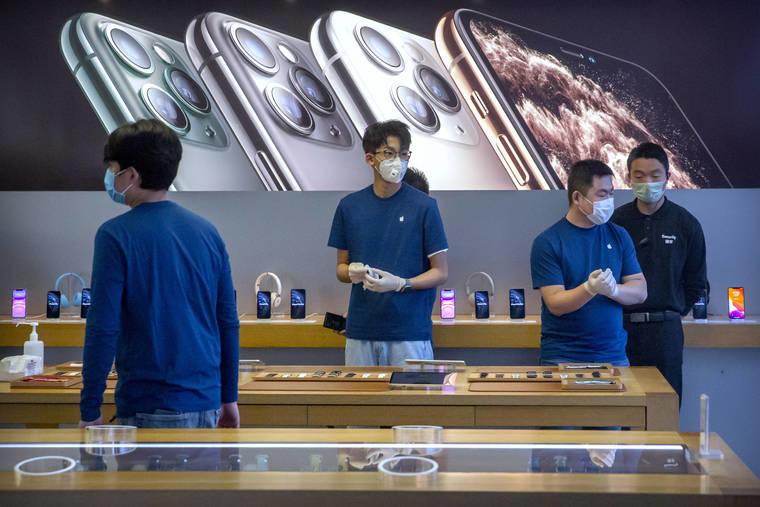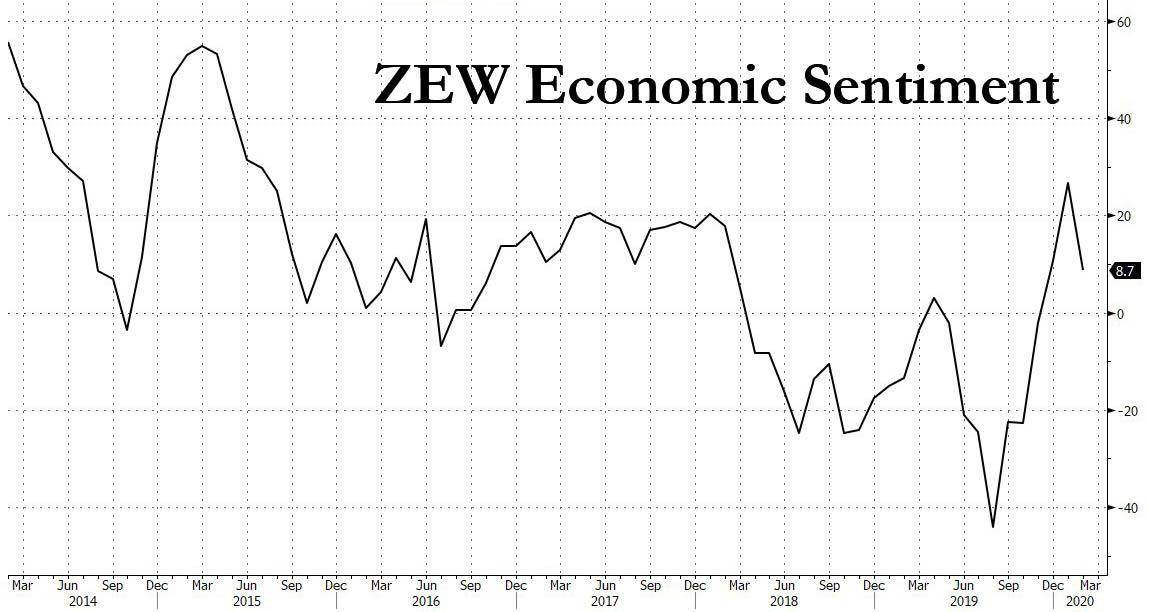Apple’s Downgrade Is Just The Tip Of The Iceberg When It Comes To Earnings Downgrades
Submitted by Eleanor Creagh of Saxo Bank,
Risk aversion is dialing up today and Asian stocks are falling along with US futures and bond yields across the curve with 30-year Treasury yields have dropping below 2% again. Anxieties are being stoked by a warning from Apple that quarterly revenue would fall short of the $63 billion to $67 billion guidance it provided a few weeks ago because of production and sales disruptions in China and operations resuming more slowly than expected.
Despite many a warning of complacency rife across equities, China mainland equities had recovered all of the losses seen following the Lunar New Year holidays and global stocks continued to climb with US stocks making a run of fresh all-time highs. This as investors are banking that ample global liquidity and supportive central banks will backstop equity prices in the face of weaker economic growth and supply chain disruptions. Commodities and haven treasuries painted a different picture, where the scale of demand destruction and caution is more visible. And in terms of pricing the eventual economic impact these markets do a better job.
As we wrote yesterday, it is our sense that the Japan 4Q GDP data miss, which is pre virus outbreak, is just a taste of what is to come in terms of downside surprises to growth. The warning from a member of the $1 trillion dollar tech club is as big a red flag as any for a market priced for perfection. Although in the current market environment where investors are expecting the hit to growth and earnings only to delay the forecast recovery and for policymakers to offset any jitters, the tendency will likely be to look through Apple’s 1Q downgrade post the initial reaction. But, Apple’s downgrade is likely just the tip of the iceberg when it comes to earnings downgrades.
Over the coming weeks, there is increased risk of continued downgrades to growth and earnings, and hard data catching down to the stark realities of the present disruptions to economic activity, travel and supply chains which could see volatility pick up. We also continue to monitor very closely the spread of COVID-19 outside of China. Today’s German ZEW survey will be a good bellwether to gauge recent sentiment shifts relating to the virus outbreak.
Shutdowns in China are now more protracted than many original expectations, many factories have not resumed production and cities are still on lockdown as measures are taken to limit the virus spread. The dashboard from capital economics shows the rate of people returning to work is a fraction of the return post 2019 LNY holiday, new home sales have completely collapsed along with coal consumption and average traffic congestion. In addition, research from Macquarie shows steel inventories at Chinese mills are now reaching the highest level on record for this period of the year, sending a warning on the near-term outlook for Chinese construction activity and demand for bulk commodities like iron ore and coking coal.
These developments and shutdowns are particularly concerning not just in terms of the direct effects but also the capacity for non-linear secondary effects to cascade as shutdowns become more protracted, this is not priced into equities. Disruptions to supply chains, travel and spending decisions will take time to stabilise and the pace of normalisation will be key to gauging the longer term effect on the global economy. China’s importance within intertwined global supply chains and interdependencies between component makers mean one missing part or stalled factory can create bottlenecks down a whole production line. Fiat Chrysler are a textbook example of this dynamic, as we wrote Friday. Fiat Chrysler will be halting their operations at a factory in Serbia due to lack of parts from China. This is a key read on how heavily intertwined global supply chains are being disrupted as the shutdowns in China trickle down production lines. Can the Eurozone’s languishing manufacturing sector afford to have nascent green shoots trampled by production bottlenecks?
These non-linear effects are the real wildcard for downgrades to economic growth and production bottlenecks and are difficult to model. This means that within any forecast outcomes an enormous degree of variability is inherent, made worse by the lack of reliable data.
For equity markets, any pickup in volatility will of course be countered by the ensuing reaction from central bankers. And in the current investing paradigm, policymakers have already exhibited their willingness to intervene with added stimulus measures in an attempt to extend the cycle, so, for as long as investors feel like central banks have their back and policy rates remain low the longer term tailwinds for equities remain. With liquidity being pumped and low yields forcing risk seeking behaviour, dip buyers are there on the sidelines ready to step in as valuations correct. And, as investors recalibrate long term interest rate expectations at current levels, large amounts of capital is enticed up the risk spectrum into equities. The next step for the market is then dependant on how reactive central banks will be in countering, any hit to growth. If the expectations of continued liquidity injections and fiscal and monetary stimulus aimed at mitigating any hit to growth are not met then market dynamics could become a lot uglier very quickly.
Although we do not want to fight liquidity we want to maintain optionality and hedge against tail risks. Namely, the impact of the virus outbreak being far greater than is currently discounted across equity markets.
Tyler Durden
Tue, 02/18/2020 – 09:10
via ZeroHedge News https://ift.tt/2HDv58M Tyler Durden

